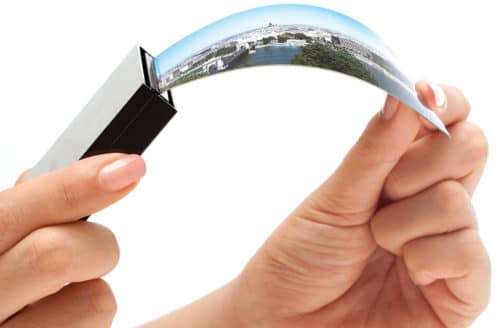Flexible displays, when they hit the market, could provide endless possibilities for design and innovation.
For decades displays have been simply flat pieces of glass or plastic that dictated the design of technology. But recently, engineers and manufacturers have been coming up with curved screens, more and more of which can be found on computer monitors, televisions and phones. Samsung Galaxy S7 Edge and LG G Flex are among the devices featuring bendable display.
With bendable display, manufacturers are looking to advance technology. In fact, flexible displays have the potential to become one of the biggest technological breakthroughs in the decade, encouraging designers to create devices we have never seen before.
But what exactly is a flexible display and why do technology majors around the world see it as the next big thing? Let’s check out.
Bendable does not mean curved
Although curved screens are impressive, these are not the same as the ones that are bent. Traditionally, liquid-crystal displays (LCDs) are sandwiches with materials that include backlight, polariser, thin-film transistor, liquid crystals and filter glass. LCDs are usually flat, but several companies like Samsung have managed to produce curved LCDs.
The recently released organic LED ecosystem (OLED) has gained popularity, thanks to its simplified design, better image quality and flexibility. OLED displays do not require backlighting, so these can be thinned and moulded into specific shapes such as the curved display on Samsung Galaxy S7. Flexibility, thinness and excellent image quality make OLED a better choice for curved screens, and it is clear that the OLED will overthrow LCD TVs in the future. However, OLEDs are currently too expensive to produce for large screens such as televisions and computer monitors, but their prices will eventually fall.
Although LCDs contain more layers than OLEDs, these screens may still be bent. Apple Japan Display is developing a 14cm (5.5-inch), full HD LCD. The display will use plastic for the substrate, which has traditionally been made of non-removable glass. This will enable it to flex and bend.
However, engineers need to come up with a way to create materials that will not break down under repeated bending stress, keeping a consistent image on the screen. This is a huge challenge.

Durability is a huge plus point in Flexible Displays
The biggest advantage of flexible displays is durability. Because the screen can be bent and manipulated, it can also absorb impact better than solid glass structures we currently have. So broken screens can be a thing of the past. However, it will take some time before we reach that point. It is assumed today that bendable screens will use plastic instead of glass, but the plastic itself can still crack under extreme stress.
Manufacturers like Corning are currently working on a flexible glass called Willow, which is planned to be put into everything from telephones to televisions to carry devices. Willow is as thin as a piece of paper and can be bent too. But it will still break if it gets too much rounded up.
Samsung, LG and Apple join the move
The three largest mobile manufacturers are reportedly experimenting with flexible displays. According to Samsung, the most important feature of Galaxy X is that its display can be folded outside, allowing users to convert their phones into 12.7cm (7-inch) tablets. LG is also said to have come out with a smartphone that folds outside to form a tablet. Patent drawings represent a conceptual LG phone that has a foldable display which can be used even after bending. Apple is considering the use of bendable displays on the iPhone in 2018.
Potential applications
Other technologies could also benefit from flexible displays. For example, flexible displays could be used as clothing that changes colour or pattern instantly as per the environment, making these particularly useful for soldiers.
Phones can also take a new format, similar to the Lenovo Cplus prototype, which starts as a thin handset but folds into a wristband. Samsung experimented with the introduction of curved displays on its original Galaxy Gear S smartphone, but moved to a more traditional flat, rounded Galaxy Gear S3. With curved displays, intelligent observers can theoretically have massive screens that surround their wrist to display even more information at once.
Cars could also use curved screens as more and more dashboards are going digital. For example, Mercedes E-Class displays infotainment indicators and infotainment data on a 31cm (12.3-inch) HD display that extends on the dashboard. Tesla and X models have a huge 43cm (17-inch) central display, but you can use a curved screen to make the outline look natural on the car’s dashboard.
The biggest challenges
The concept of bent displays is not new, because gadget manufacturers appear to be displaying them on large shows like CES (Consumers Electronics Show in Las Vegas, USA) and MWC (Mobile World Congress in Barcelona, Spain) annually, but no one has brought a flexible display to the market yet. Why?Since bending the display is difficult, crafting a device that uses one effectively is even more difficult. In order to create a flexible product, manufacturers need to know how to make each component flexible. Batteries are particularly difficult to bend because the current technology requires batteries to keep their shape. After being bent, batteries are short-circuited and, if shorted too far in the housing, can explode.
Both LG and Samsung have been working on a flexible battery for many years, but the technology is still not available. So far, the only way to use a curved display is to make a device that bends on the hinge. This concept works with the Lenovo Yoga Book, which is equipped with a touchscreen and a touchpad that doubles as a drawing tablet. With the hinge, device manufacturers can potentially use fixed batteries and silicon, but add a fold to them.
We are still waiting for the first device to hit the market, but when it arrives, we can expect durability and endless possibilities in design and innovation. Over the last few years, the patterns of phones and tablets have been outdated, and flexible displays can make them exciting again.








